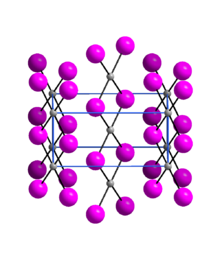Chemistry:Palladium(II) iodide

| |
| Identifiers | |
|---|---|
3D model (JSmol)
|
|
| ChemSpider | |
| EC Number |
|
PubChem CID
|
|
| |
| |
| Properties | |
| I2Pd | |
| Molar mass | 360.229 g/mol |
| Appearance | Black crystals |
| Density | 6,003 g/cm3 |
| Melting point | 350 °C (decomposes) |
| Insoluble in water | |
| Hazards | |
| GHS pictograms | 
|
| GHS Signal word | Warning |
| H315, H319, H335 | |
| Related compounds | |
Other anions
|
Palladium(II) fluoride Palladium(II) chloride Palladium(II) bromide |
Except where otherwise noted, data are given for materials in their standard state (at 25 °C [77 °F], 100 kPa). | |
| Infobox references | |
Palladium(II) iodide is an inorganic compound of palladium and iodine. It is commercially available, though less common than palladium(II) chloride, the usual entry point to palladium chemistry. Three polymorphs are known.[2]
Preparation
Palladium(II) iodide can be obtained by treating a dilute solution of palladium in nitric acid with sodium iodide at 80 °C.[2]
The high-temperature polymorph α-palladium(II) iodide can be produced by reaction of the elements at temperature above 600 °C. The γ-modification is produced as an almost amorphous powder by addition of iodide salts to aqueous H2PdCl4 solution . When heated in dilute hydrogen iodide solution, this polymorph transforms into the β phase at around 140 °C.[3]
Reactions and uses
Palladium(II) iodide is insoluble in water. It reacts with iodide giving PdI42− anion:
- PdI
2 + 2I−
→ PdI2−
4
It finds use as a catalyst.[4]
Historically, the quantity of palladium in a solution may be determined gravimetrically by precipitation as palladium(II) iodide.[5]
Crystallography
Palladium(II) iodide is an almost X-ray amorphous black powder. The α-modification has an orthorhombic crystal structure with the space group Pnmn(space group no. 58, position 5).[6]
References
- ↑ "C&L Inventory". https://echa.europa.eu/information-on-chemicals/cl-inventory-database/-/discli/details/115514.
- ↑ 2.0 2.1 Handbuch der präparativen anorganischen Chemie. 3 (3., umgearb. Aufl ed.). Stuttgart: Enke. 1981. ISBN 978-3-432-87823-2.
- ↑ Brendel, Kristin; Thiele, Gerhard (2001). Binäre und Ternäre Verbindungen der Platinmetalle Palladium und Rhodium mit Tellur und Halogenen. Präparationen und strukturelle Charakterisierung.. https://freidok.uni-freiburg.de/data/197.
- ↑ Gabriele, Bartolo; Salerno, Giuseppe (2006) (in en), Palladium(II) Iodide, American Cancer Society, doi:10.1002/047084289x.rn00658, ISBN 978-0-470-84289-8, https://onlinelibrary.wiley.com/doi/abs/10.1002/047084289X.rn00658, retrieved 2021-03-26
- ↑ Beamish, F. E.; Dale, J. (1938). "Determination of Palladium by Means of Potassium Iodide". Industrial & Engineering Chemistry Analytical Edition 10 (12): 697. doi:10.1021/ac50128a015.
- ↑ Ans, Jean d'; Lax, Ellen (1998) (in de). Taschenbuch für Chemiker und Physiker. Springer. ISBN 978-3-540-60035-0. https://books.google.com/books?id=ssy59etLaksC&pg=PA668.
| HI | He | ||||||||||||||||
| LiI | BeI2 | BI3 | CI4 | NI3 | I2O4, I2O5, I4O9 |
IF, IF3, IF5, IF7 |
Ne | ||||||||||
| NaI | MgI2 | AlI3 | SiI4 | PI3, P2I4 |
S | ICl, ICl3 |
Ar | ||||||||||
| KI | CaI2 | Sc | TiI4 | VI3 | CrI3 | MnI2 | FeI2 | CoI2 | NiI2 | CuI | ZnI2 | Ga2I6 | GeI2, GeI4 |
AsI3 | Se | IBr | Kr |
| RbI | SrI2 | YI3 | ZrI4 | NbI5 | Mo | Tc | Ru | Rh | Pd | AgI | CdI2 | InI3 | SnI4, SnI2 |
SbI3 | TeI4 | I | Xe |
| CsI | BaI2 | HfI4 | TaI5 | W | Re | Os | Ir | Pt | AuI | Hg2I2, HgI2 |
TlI | PbI2 | BiI3 | Po | AtI | Rn | |
| Fr | RaI2 | Rf | Db | Sg | Bh | Hs | Mt | Ds | Rg | Cn | Nh | Fl | Mc | Lv | Ts | Og | |
| ↓ | |||||||||||||||||
| La | Ce | Pr | Nd | Pm | SmI2 | Eu | Gd | TbI3 | Dy | Ho | Er | Tm | Yb | Lu | |||
| Ac | ThI4 | Pa | UI3, UI4 |
Np | Pu | Am | Cm | Bk | Cf | EsI3 | Fm | Md | No | Lr | |||
 |

